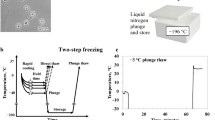Abstract
The aim of this study was to present a non-trypsin 3D cell culture method with a reversible thermosensitive HBCS hydrogel. In this study, hydroxybutyl chitosan (HBCS) was synthesized by grafting hydroxybutyl groups on chitosan molecule chains. The prepared HBCS was water-soluble, and the reversible phase transformation temperature was 26 °C. Scanning electron microscope images illuminated the 3-D network of hydrogel formed irregular porous structure which ranged from 50–250 μm. Cell viability assay indicated that HBCS solution could promote the proliferation of human umbilical vein endothelial cells (HUVECs), and the boost of proliferation was enhanced with the increase of HBCS concentration. HBCS had no harm to the nitric oxide (NO) synthesis functionality of HUVECs. HUVECs could grow and reproduce inside the hydrogel, and showed good vitality after 14-days culture. Meanwhile, cells cultured inside the hydrogel could be passaged successively through the reversible phase transformation process of HBCS. The results revealed that HBCS have the potential to be used for 3-D cell culture without the use of trypsin.







Similar content being viewed by others
References
Chilkoti A, Dreher MR, Meyer DE, Raucher D. Targeted drug delivery by thermally responsive polymers. Adv Drug Deliv Rev. 2002;54:613–30.
Wang Y, Yuan ZC, Chen DJ. Thermo-and pH-sensitive behavior of hydrogels based on oligo (ethylene glycol) methacrylates and acrylic acid. J Mater Sci. 2012;47:1280–8.
Ji QX, Zhao QS, Deng J, Lu R. A novel injectable chlorhexidine thermosensitive hydrogel for periodontal application: preparation, antibacterial activity and toxicity evaluation. J Mater Sci Mater Med. 2010;21:2435–42.
Liu Y, Chan-Park MB. Hydrogel based on interpenetrating polymer networks of dextran and gelatin for vascular tissue engineering. Biomaterials. 2009;30:196–207.
Zhao QS, Cheng XJ, Ji QX, Kang CZ, Chen XG. Effect of organic and inorganic acids on chitosan/glycerophosphate thermosensitive hydrogel. J Sol-Gel Sci Technol. 2009;50:111–8.
Zeng Q, Chen W. The functional behavior of a macrophage/fibroblast co-culture model derived from normal and diabetic mice with a marine gelatin-oxidized alginate hydrogel. Biomaterials. 2010;31:5772–81.
Wall ST, Walker JC, Healy KE, Ratcliffe MB, Guccione JM. Theoretical impact of the injection of material into the myocardium: a finite element model simulation. Circulation. 2006;114:2627–35.
Wang T, Jiang XJ, Tang QZ, Li XY, Lin T, Wu DQ, Zhang XZ, Okello E. Bone marrow stem cells implantation with alpha-cyclodextrin/MPEG-PCL-MPEG hydrogel improves cardiac function after myocardial infarction. Acta Biomater. 2009;5:2939–44.
Dang JM, Sun DDN, Yoshitsune SY, Sieber AN, Kostuik JP, Leong KW. Temperature-responsive hydroxybutyl chitosan for the culture of mesenchymal stem cells and intervertebral disk cells. Biomaterials. 2006;27:406–18.
Drury JL, Mooney DJ. Hydrogels for tissue engineering: scaffold design variables and applications. Biomaterials. 2003;24:4337–51.
Balakrishnan B, Jayakrishnan A. Self-cross-linking biopolymers as injectable in situ forming biodegradable scaffolds. Biomaterials. 2005;26:3941–51.
Sun B, Ma W, Su F, Wang Y, Liu J, Wang D, Liu H. The osteogenic differentiation of dog bone marrow mesenchymal stem cells in a thermo-sensitive injectable chitosan/collagen/beta-glycerophosphate hydrogel: in vitro and in vivo. J Mater Sci Mater Med. 2011;22:2111–8.
Jeong B, Kim SW, Bae YH. Thermosensitive sol-gel reversible hydrogels. Adv Drug Deliv Rev. 2002;54:37–51.
Li N, Yu M, Deng L, Yang J, Dong A. Thermosensitive hydrogel of hydrophobically-modified methylcellulose for intravaginal drug delivery. J Mater Sci Mater Med. 2012;23:1913–9.
Degoricija L, Bansal PN, Söntjens SH, Joshi NS, Takahashi M, Snyder B, Grinstaff MW. Hydrogels for osteochondral repair based on photocrosslinkable carbamate dendrimers. Biomacromolecules. 2008;9:2863–72.
Fan J, Shang Y, Yuan Y, Yang J. Preparation and characterization of chitosan/galactosylated hyaluronic acid scaffolds for primary hepatocytes culture. J Mater Sci Mater Med. 2010;21:319–27.
Chung TW, Lu YF, Wang SS, Lin YS, Chu SH. Growth of human endothelial cells on photochemically grafted Gly-Arg-Gly-Asp (GRGD) chitosans. Biomaterials. 2002;23:4803–9.
Huang Y, Onyeri S, Siewe M, Moshfeghian A, Madihally SV. In vitro characterization of chitosan–gelatin scaffolds for tissue engineering. Biomaterials. 2005;26:7616–27.
Song K, Qiao M, Liu T, Jiang B, Macedo HM, Ma X, Cui Z. Preparation, fabrication and biocompatibility of novel injectable temperature-sensitive chitosan/glycerophosphate/collagen hydrogels. J Mater Sci Mater Med. 2010;21:2835–42.
Mourya VK, Inamdar NN. Trimethyl chitosan and its applications in drug delivery. J Mater Sci Mater Med. 2009;20:1057–79.
Franco RA, Nguyen TH, Lee BT. Preparation and characterization of electrospun PCL/PLGA membranes and chitosan/gelatin hydrogels for skin bioengineering applications. J Mater Sci Mater Med. 2011;22:2207–18.
Zhang WF, Chen XG, Li PW, Liu CS, He QZ. Preparation and characterization of carboxymethyl chitosan and b-cyclodextrin microspheres by spray drying. Dry Technol. 2008;26:108–15.
Wei CZ, Hou CL, Gu QS, Jiang LX, Zhu B, Sheng AL. A thermosensitive chitosan-based hydrogel barrier for post-operative adhesions’ prevention. Biomaterials. 2009;30:5534–40.
Chen B, Dang J, Tan TL, Fang N, Chen WN, Leong KW, Chan V. Dynamics of smooth muscle cell deadhesion from thermosensitive hydroxybutyl chitosan. Biomaterials. 2007;28:1503–14.
Dang QF, Yan JQ, Lin H, Chen XG, Liu CS, Ji QX, Li JJ. Design and evaluation of a highly porous thermosensitive hydrogel with low gelation temperature as a 3D culture system for Penaeus chinensis lymphoid cells. Carbohydr Polym. 2012;88:361–8.
Tan H, Chu CR, Payne KA, Marra KG. Injectable in situ forming biodegradable chitosan–hyaluronic acid based hydrogels for cartilage tissue engineering. Biomaterials. 2009;30:2499–506.
Achneck HE, Sileshi B, Lawson JH. Review of the biology of bleeding and clotting in the surgical patient. Vascular. 2008;16:S6–13.
Rowley JA, Madlambayan G, Mooney DJ. Alginate hydrogels as synthetic extracellular matrix materials. Biomaterials. 1999;20:45–53.
Acknowledgments
This work was supported by Grants from the National Natural Science Foundation of China (NSFC, 81071246), International S&T Cooperation Program of China (ISTCP, 2012DFB50140), and Shandong province science and technology development project (2011GSF12124).
Author information
Authors and Affiliations
Corresponding authors
Rights and permissions
About this article
Cite this article
Wei, Y.N., Wang, Q.Q., Gao, T.T. et al. 3-D culture of human umbilical vein endothelial cells with reversible thermosensitive hydroxybutyl chitosan hydrogel. J Mater Sci: Mater Med 24, 1781–1787 (2013). https://doi.org/10.1007/s10856-013-4918-1
Received:
Accepted:
Published:
Issue Date:
DOI: https://doi.org/10.1007/s10856-013-4918-1




